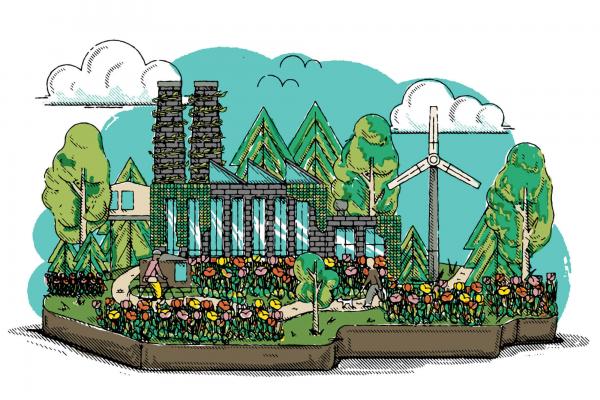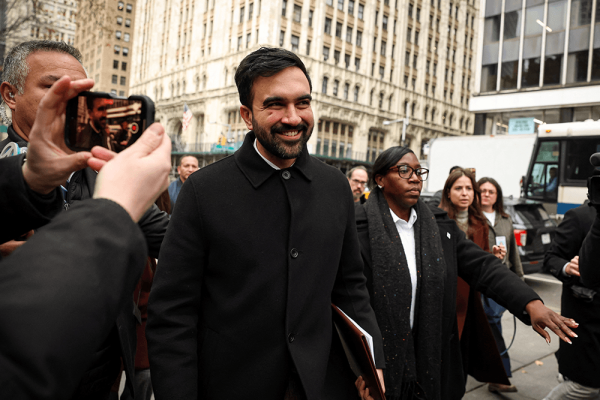SOON AFTER SENATE Majority Leader Mitch McConnell brought the resolution for a Green New Deal to a sham procedural vote in March, a clip of its co-sponsor, Alexandria Ocasio-Cortez, went viral.
“You want to tell people that their concern and their desire for clean air and clean water is elitist? Tell that to the kids in the South Bronx which are suffering from the highest rates of childhood asthma in the country,” Ocasio-Cortez said. “Tell that to the families in Flint whose kids’ blood is ascending in lead levels.”
It was an illuminating statement. The Green New Deal had rapidly emerged on the heels of a report by the U.N. Intergovernmental Panel on Climate Change that puts the deadline for massive, coordinated action to avoid the worst of climate change at 12 years out. Now is the time for an audacious proposal of the kind climate activists have long pushed for, one that matches the planetary crisis in scale and scope.
Indeed, calling it the Green New Deal was an intentional reference to the national mobilization that resuscitated America from the Great Depression. Shortly after the GOP-controlled Senate voted down the Green New Deal (for now), The New York Times eulogized it as a “grand reimagining” of “sweeping ambitions.”
Maybe so. But foremost in Ocasio-Cortez’s mind? The families of Flint. The kids in the Bronx.
While climate change will indeed require a radical remaking of our economic system and of global society, its impacts only mean something when they hit home. A Green New Deal was never meant to accomplish everything at the federal level. Ocasio-Cortez herself called it simply a “vision document”—with broad outlines shaped by years of advocacy by environmental justice groups on the ground. It’s clear that any future version of the Green New Deal must be rooted in communities—supporting and building up from the work they have long been doing.
“In order to succeed, the Green New Deal must center and support the work being done by the frontline of the climate crisis and work with us, not speak for us,” Elizabeth Yeampierre, executive director of the Brooklyn-based environmental justice group UPROSE, told me in an email. Yeampierre was part of a delegation of the Climate Justice Alliance that met with Ocasio-Cortez and influenced the language in the resolution. And the Green New Deal does include several provisions that involve working with locals at the community level to facilitate the transition away from a fossil-fuel economy.
One such provision, involving “building resiliency against climate-change-related disasters” by “providing investments for community-defined projects,” might as well have cited UPROSE by name. For years the activists of UPROSE have been protesting and urging reconsideration from New York City officials and private developers who seek to transform their native Sunset Park, Brooklyn, into “Industry City”—a slick development expansion on the borough waterfront that the group says will pre-empt equitable climate-resiliency projects and eventually displace them through gentrification. In March 2019, after local officials intervened, Industry City plans were put on hold pending more community consultation.
Another project proposed in the Green New Deal includes working collaboratively with farmers to build “a more sustainable food system that ensures universal access to healthy food.” Those doing so might take a page from Familias Unidas por la Justica, a farmworkers union in Washington state that has developed an alternative cooperative, Cooperativa Tierra y Libertad. Farmworkers participating in the co-op can escape virtual indentured servitude at corporate farming operations and instead, according to The Nation, “decide everything from how to produce and distribute their crops, to what tasks need to be completed each day” and can become worker-owners of the land itself.
Likewise, the Huntley Alliance in Tonawanda, a suburb of Buffalo, New York, provides a neat model for what the Green New Deal resolution calls “prioritizing high-quality job creation and economic, social, and environmental benefits in frontline and vulnerable communities and deindustrialized communities” that “may otherwise struggle with the transition” away from a fossil fuel economy. After a coal-fired power plant in town shut down, the alliance successfully pushed the state of New York to provide “gap funds” to keep the city up and running until it could transition to its new economy.
“If a state as geographically, politically, and economically complicated as New York is capable of this,” an expert in sustainable planning told Grist, “then other states can look for parallels.”
The IPCC report has many believing there are just 12 years left until utter catastrophe. But the truth is, there’s no precise moment that will mark the end of the whole world. The safety and stability of your world, as you know it, depends largely on where you live and the capacity your community has to respond to its immediate conditions. And it’s this deep, place-based knowledge baked into community organizations that will lead the necessary reorganization of society.
“Climate policy might befuddle Democratic leadership,” Julian Brave Noisecat of 350 Action put it in a Times opinion column, “but the grassroots knows what’s up.”

Got something to say about what you're reading? We value your feedback!






